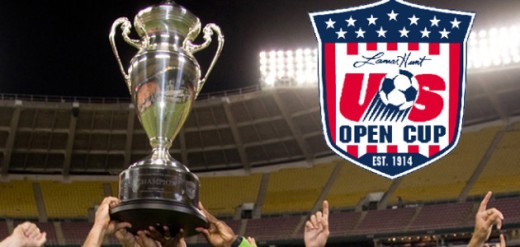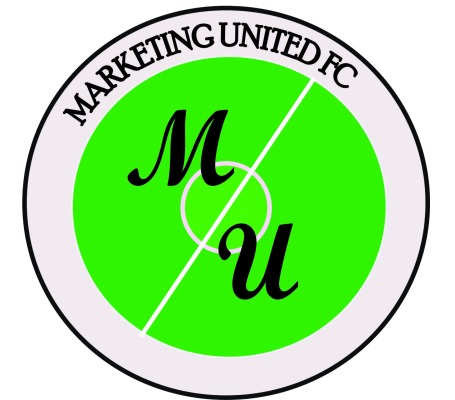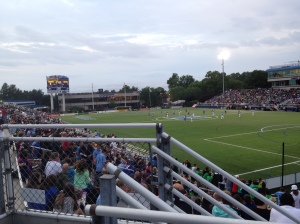
England has the F.A. Cup and the Capital One Cup. Germany has the DFB-Pokal. Italy has the Coppa Italia. The United States has…the Lamar Hunt U.S. Open Cup. It may be a mouthful, but as the only American cup competition still running since 1914, it’s the oldest tournament in the American sports landscape. But year after year with little change, the question still arises: why isn’t the U.S Open Cup a bigger deal?
Last night concluded the fourth round of US Open Cup action and there were some exciting match-ups, albeit sparse crowds. In perhaps the most highly attended game, the New York Cosmos of NASL defeated New York City FC of MLS for the second straight year in front of nearly 7,000 fans at Fordham University in the Bronx. Other games of note involved the Houston Dynamo (MLS) defeating San Antonio FC (USL, third division) in front of just under 6,000 fans, FC Dallas (MLS) defeating Oklahoma City Energy FC (USL) in a stadium with a capacity of 1,500 that did not appear full, and Orlando City FC (MLS) defeating Jacksonville Armada (NASL) in front of a capacity crowd of 2,158 fans in Jacksonville. All in all, these attendance figures aren’t exactly a magnet for attracting sponsors.
But more sponsorship just might be the injection of life that this tournament needs. If we look across the pond, England’s storied F.A. Cup has been around since 1871, so virtually everyone in the country knows about it and adding a name brand to the name would do no good. For better or for worse, most people would still call it the F.A. Cup. But the League Cup has only been around since 1960, and that’s why corporate sponsors like Carling and Capital One have attached their names to the tournament over the past decade. Associating a brand with a sporting event is effective when fans describe the event using the brand name. Associating a brand with a sporting event is also an effective way of generating the necessary funds to market the event in the first place. That being said, why not add a naming sponsor to the U.S Open Cup?
Lamar Hunt was one of the founding fathers of Major League Soccer. As long as his name is still engraved on the trophy, he could still be honored. But for marketing purposes, if his name was to be replaced or followed by a sponsor willing to pay a plethora of money for a long-lasting association with one of the most growing team sports in America, the growth of the league that he helped build in life could accelerate after his passing. But first, there has to be a sponsor willing to take the gamble.
In Italy, the Coppa Italia that has been around since 1922 was rebranded as the TIM Cup, after its sponsor, Telecom Italia. For a tournament with such a long, rich history, the chances of it being referred to as Coppa Italia are still higher than Telecom Italia would like. But when a fan sees the TIM logo now, they have a far greater chance of associating the company with soccer.
If that positive association with a brand makes the fan buy the product or service, then both the league and the sponsor can be happy because the sponsorship worked as intended. When a sponsorship is done right, everybody wins. Some fans may disapprove of how much commercialism has been injected into the game, but even the most skeptical fans acknowledge that a little commercialism is necessary to pay for the players, the staff, the coaches, and all the moving pieces that make all sports what they have become today.
Overall, a team from MLS that wins the whole event plays an extra five games on top of their league schedule of thirty two games starting in June, and ending in September. The league games usually start at the end of March and end in late November. Instead of an All-Star break, MLS should incorporate two rounds of Open Cup action into that break, and hype up those rounds as must-see TV. The remaining three rounds could mean starting the week before the MLS season in March, and the two weeks at the end of the MLS season in November/December that way the schedule is less forced. Taking a page out of England’s book, the final could be played in a neutral venue that bids to host the event like the Super Bowl.
In short, there are few steps needed to make the U.S. Open Cup a bigger deal. First, get a title sponsor. The AT&T or Verizon or Geico U.S. Open Cup would be prime examples. Next, use the money from the title sponsorship agreement to offer the winning team a significant prize, not just the measly $250,000 split that teams currently win. And finally, change the timing of the whole tournament so that the games fit better into the current calendar rather than playing the games on weekdays in small college fields that are difficult to find. Slowly but surely, we just might be able to make the U.S. Open Cup the spectacle it deserves to be.

 onight is the U.S. Open Cup, the American equivalent to England’s F.A. Cup, Italy’s Coppa Nazionale, and Spain’s Copa Del Rey. The game is between a team in the thick of an MLS Cup Playoff push, Sporting Kansas City, and a team on the outside looking in, the Philadelphia Union. If Sporting Kansas City wins this year, it will be their third trophy in four years (U.S Open Cup Champs 2012, and MLS Cup Champs 2013). If Philadelphia wins tonight, it will be the club’s first piece of hardware in its 6 year history.
onight is the U.S. Open Cup, the American equivalent to England’s F.A. Cup, Italy’s Coppa Nazionale, and Spain’s Copa Del Rey. The game is between a team in the thick of an MLS Cup Playoff push, Sporting Kansas City, and a team on the outside looking in, the Philadelphia Union. If Sporting Kansas City wins this year, it will be their third trophy in four years (U.S Open Cup Champs 2012, and MLS Cup Champs 2013). If Philadelphia wins tonight, it will be the club’s first piece of hardware in its 6 year history.